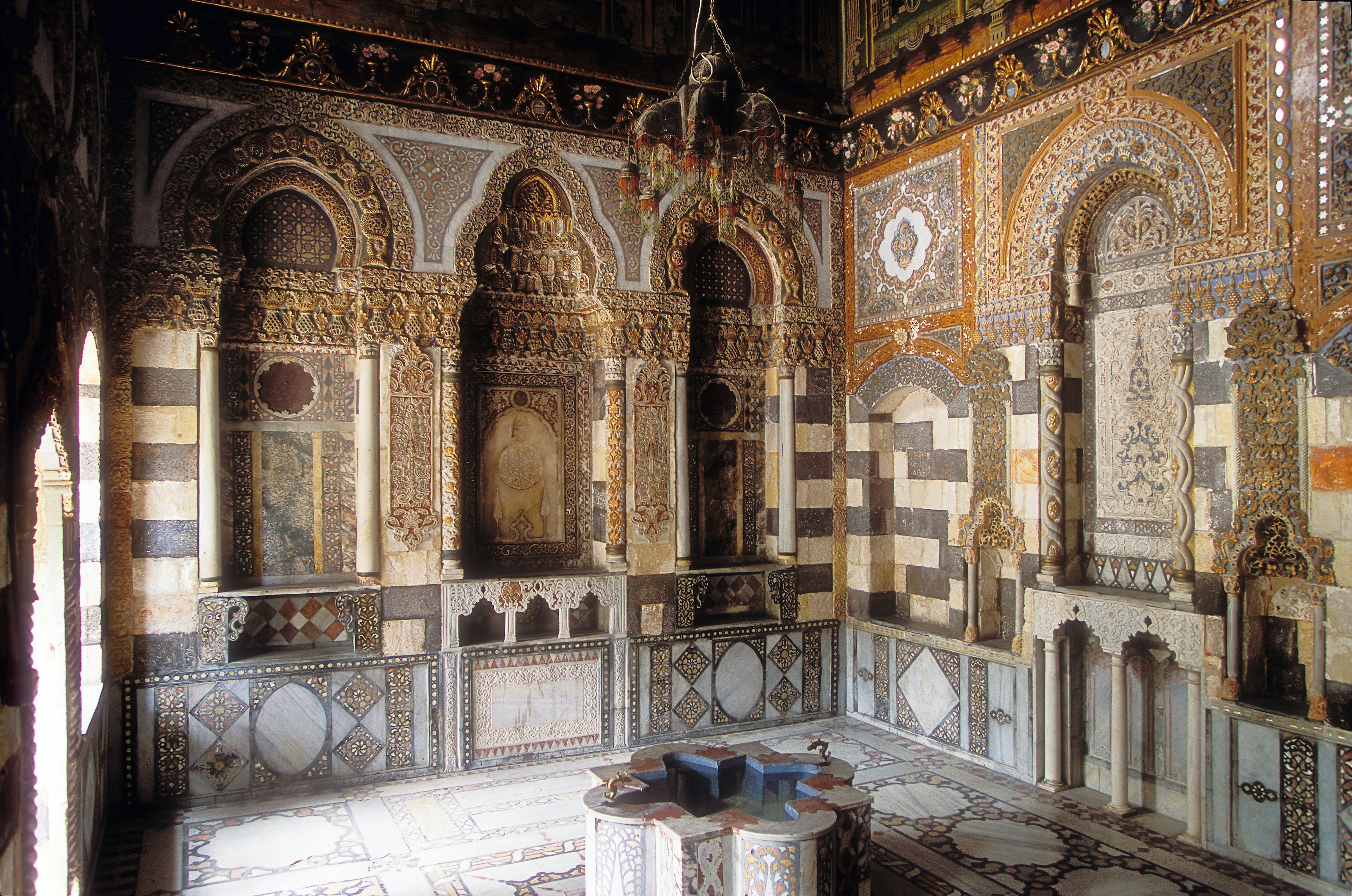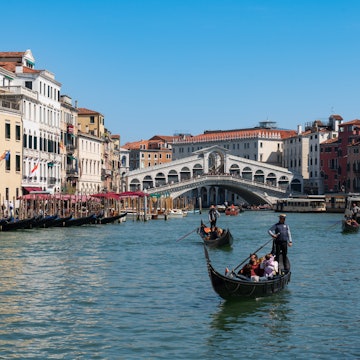

The Umayyad Mosque, which is also suitably known as the Grand Mosque of Damascus, has been a site of worship since the 9th century CE © Pascal Meunier
We're taking a look through our archive of travel writing to highlight all the ways the world has changed, as well as some of the ways it's stayed the same. In this essay from 2009, Tahir Shah visits Damascus, Syria, two years before the country would be thrown into civil war. While there, he seeks out tales of history and myth amid the crumbling palaces and curious souqs.
Salim the son of Suleiman was reclining on an ancient Damascene throne in a patch of sunlight at the back of his antique shop. His eyes were closed, the face around them lined with creases, its cheeks obscured by a week’s growth of tattered grey beard. As he slept off a lunch of mutton kebabs, his fingertips caressed fragments of ivory inlaid on the throne’s regal arm.
Lost in the shadows between the front door and the chair lay a treasury of objects, a spider’s web of clutter gleaned from centuries of Damascus life. There were Crusader battle standards blackened by fire, tortoise-shell jewel boxes and Qur’an stands carved from great slabs of teak, epaulettes and chamber pots, fountainheads fashioned in the form of gazelle, mosque lamps and astrolabes, vast gilt mirrors and bull elephant tusks.
Before leaving home I had found a visiting card from the very same antique emporium, in a file packed with my grandfather’s papers. An Afghan writer and diplomat, he had visited Damascus 75 years before me, and had written a book about the journey, entitled Alone in Arabian Nights. I was pleased to not only see the shop still standing, but to find it filled with such a treasure trove of wares.
At the sound of a customer’s feet, Salim opened an eye. He scanned the room, jolted up, and let the kitten curled on his chest tumble to the floor.
"Can I interest you in an amulet," he said with a grin, "to keep you safe on Syrian roads?"
"I don’t believe in all that," I replied.
The shopkeeper’s smile melted away. "Shhhh!" he hissed. "You mustn’t say such things."
"Why not?"
"Because he’s listening, up there!"
We both cocked our heads to look at the ceiling, and I changed the subject. I asked the price of a fabulous ceremonial axe that had caught my eye, its blade was crafted from watered steel, inscribed with a spell. Salim wagged a finger in my direction.
"Everything is for sale except that," he said.
"Why’s it different?’"
"I cannot tell you."

Salim the son of Suleiman brewed a pot of tea and sat in silence, while I begged him to sell me the axe. The more I implored, the more he shook his head. After an hour of sweet tea and failed persuasion, I strolled out into the thin daylight, feeling as if somehow I had been robbed of the opportunity of parting with my money.
Visit the Old City of Damascus and you're struck by a sense of living antiquity, and by the gems which fill the emporia hidden within its shadows. Explore the teeming souqs and you descend down through layer upon layer, onion-skins of life, stretching back 20 centuries or more. I have never been in a place where the antiques and bric-à-brac of a city fit so squarely against the backdrop of humanity.
Trawl through the loot on sale, and the waves of past invaders stare you in the face. The Greeks were there, and after them the Romans and Byzantine Christians. Then came the Umayyad Caliphate and, after it, the Abbasids, the Fatimids and the Seljuk Turks. The Crusades gave way to Mamluk rule, itself followed by the conquests of Tamerlane, the Ottomans and, after them, the French.
Mark Twain was spot on when, in the 1860s, he wrote, "To Damascus, years are only moments, decades are only flitting trifles of time. She measures time not by days, months and years, but by the empires she has seen rise and prosper and crumble to ruin."
The American author's visit to Damascus coincided with the Victorian preoccupation for all things Arabian. The interest was partly fueled by the translation of the Thousand and One Nights. European parlors were suddenly awash with exotic furniture, tiles and silks from Arabia.
In the 1800s, intrepid adventurers like Twain visited Damascus and were awed by it, while others swapped their London townhouses for palaces hidden in the depths of the Old City. Perhaps the most famous was the orientalist Richard Burton.
He arrived on 1 January 1870, not long after Mark Twain had passed through. Employed as British Consul, Burton found himself in a melting pot of ancient and modern, a rare blend of Arab life that he regarded as utter paradise. It's easy to imagine his delight – after all, his consulate was supposedly housed in one of the grandest palaces of all, the fabulous Beit Quwatli. It's now divided into homes and storerooms, and in a terrible state of repair, but the interior harks back to a time when the Syrian capital was one of the most sophisticated cities in existence.

Forgotten palaces
For me, a journey to Damascus is a treasure hunt from beginning to end, a slice through layers of history in search of gems. Seeking out the palaces – ruined and restored – is a great way to glimpse at centuries past. It's true that some buildings have been destroyed, and that others have endured botched restorations, but there are real treasures awaiting anyone with a sense of adventure and a little time.
A good number of guidebooks show where the most sublime houses lie. When you find them, there aren't any turnstiles or tourist lines, just a watchman, if you're lucky, to open the door when you knock. The ceilings may have fallen in and the frescoes might be cracked, but squint a little, use your imagination, and it all comes vibrantly to life. Very soon you can hear the sound of music and conversation, and smell the scent of fleurs d'oranges as the hostess sweeps through the room.
A Damascene mansion's reception rooms were designed to astonish visitors, awing them with a sense of wonder. Many of the buildings were the property of powerful political families, rather than successful merchants. And so the mansions themselves were an expression of political power and aspiration. Of them all, the most extraordinary, and the easiest to visit now, is the 18th-century Beit Nizam, located on a narrow residential lane off Straight Street.
From the outside, nothing at all is given away. But ring the bell, wait for the guardian to get up from his nap, and you enter a dream world of Arabian fantasy. The house boasts three courtyards and many reception rooms as grand as anything on earth. There are alabaster colonnades and marble floors inset with quartz, octagonal fountains and gilded doors, fabulous painted ceilings and stained glass, turquoise Iznik tiles, exquisite lamps, and murals festooning the walls.

The house is silent now except for birdsong in the orange trees. The stillness bridges the century and a half since the mansion was a hub for high society. Stroll the courtyards and it's easy to imagine the exiled Algerian leader, Abd al-Qadir, sitting in the shade, chatting with Burton or their scandalous friend Lady Jane Digby.
But the longer you spend in palaces like Beit Nizam, the more you find yourself touched by melancholy. As I traipsed around the Old City, marveling at the shattered time-capsules, I got a sense that no one really cared except for me. It was as if the bandwagon had rolled out of town. The guardians were blasé about the grandeur, as were the ubiquitous families of cats perched on the rooftops; and the local Damascenes were too busy struggling with the present to give a care for the past.
The most poignant sense of sorrow surrounded the home of Jane Digby. An English socialite and aristocrat, she had exiled herself to Damascus at the age of 45. It must have been the one place she could think of where her reputation had not yet reached. In Europe, the drawing rooms of society resounded to gossip of her indecent liaisons. She had been married young to an English baron, before being divorced by him for having numerous affairs, including one with her own cousin. Freed from marriage, Lady Jane embarked on wild relationships, including King Ludwig I of Bavaria and, after him, with his son, King Otto of Greece.

House hunting
Lady Jane spent half the year near Palmyra in goat hair tents with her lover, a Bedouin sheikh 20 years her junior. The other half of the year was passed in Damascus, in a house just outside the walls of the Old City. I heard the building had been rediscovered by lady Jane's biographer, Mary Lovell. With time to spare, I went in search of it for myself. I had rough directions, but they were of little use until, that is, I came across a small shop where electrical motors were being repaired. Mohamed, the owner, was having lunch at a workbench strewn with wire, dismembered fans and grease. As I entered with my makeshift map, he insisted I join him. In the Arab world, a visitor must be received with hospitality irrespective of circumstance.
Lunch was followed by tea and a blow-by-blow account of Mohamed's youth. After that, he guided me through an album of pictures of his extended family, and served yet more tea. Three hours after my arrival, I inquired politely if he might show me the house of Lady Jane. He seemed confused, then smiled. "Follow me," he said.
We left the workshop and went round the corner and down an alley no wider than a man. Mohamed rang a bell high on the doorframe. After some time, an old woman poked her veiled head out and I was ushered inside. The palace of Beit Nizam had impressed me for its sheer grandeur and indulgence, but nothing has ever touched me quite like the home of Lady Jane.
The house had been divided up among as many as 30 families, but the famous octagonal parlor remained in near-perfect condition. The walls were covered with the original handmade paper, brought from London by Lady Jane herself. Fitted cupboards stood in each corner, their doors inlaid with filigree. The ceiling – partly concealed by a crude mezzanine floor – was octagonal, its central medallion ornamented with little mirrors. Three generations of a family lived in the two rooms now. They were clustered on vinyl couches with bouquets of plastic flowers all around, watching Baywatch on an old TV. Before leaving, I took a mental snapshot, and wondered what Lady Jane might have made of the scene.

Awash with history
Back in the covered bazaar, the traders were getting ready for the evening rush, when Damascenes take a stroll before dinner. Brisk business was being done in saffron, mothballs and underpants, in pumice, plastic buckets and olive oil soap. One shop was far busier than the rest. Its back wall lined with jars filled with curious ingredients – sulfur, dried chameleons and oak apples. Dangling from a string near the light was a clutch of tortoise shells, eagles' wings and salamanders' tails. Veiled women wandered over, handing scribbled lists to the apothecary who, in turn, would weigh out a handful of roots, damask roses, poppy seeds or a dried starfish.
In a narrow alley a stone's throw away, a hunched old craftsman was hammering a strand of steel beside a forge. His workshop was blackened with soot, his hands as coarse as sandpaper. The swordsmith paused to greet me, and held the blade into the light for me to examine his work. Damascus was once famed for so-called "watered steel," a technique known as damascening that leaves a fluid-like grain on the metal. Blades of astonishing sharpness were fashioned until the 18th century when the technique was lost.
Nearby, in Souq al-Khayyatin, the tailor's bazaar, I came across a series of chambers where red and white kafir headscarves were being woven on great cast-iron looms, each one imported from France more than a century ago. The chambers were vaulted, their frescoed walls hinting at the former use of the place, as a hammam. The brocade spinners now populate the magnificent central steam room, its ceiling crowned by an octagonal cupola.
Inspired by the ruined bathhouse, I decided to follow Arab tradition and visit a hammam. Bathing is extremely popular across the Islamic world, and is a way for friends to spend time together relaxing, as much as it is a means to get clean. The hammams of Damascus are legendary, and many date back over 1000 years. It's certain that there have been bathhouses in the city since Roman times.
The Hammam al-Selsela, close to the Umayyad Mosque, was recommended to me. Its owner, another Mohamed, was slouched on a chair near the doorway, watching an Egyptian soap opera on a portable TV. "A clean man has a pure heart," he whispered as I entered, quoting a favored Syrian proverb. His family had run the bathhouse for generations, he said, and he knew most of the customers by name. Many of them were lounging about in the central salon, chatting, smoking shisha and drinking sweet tea.

Wrapped in a towel, I shuffled past them into the blistering steam room. After being scalded and scrubbed down to the bone with a sliver of pumice, I shuffled out again, squeaky clean. Mohamed spat out another proverb with a grin as he took my money: "Clean feet leave no footprints." Then he directed me to the Nawfara Café on the other side of the Umayyad Mosque. He said that if I heard the storyteller there, I would be the happiest man alive. It was a prospect too good to pass up.
Telling stories
The Nawfara is an institution in Damascus, and a perfect people-watching haunt. You get the feeling that entire lives have been swallowed up there. Inside, a waiter hurried around replenishing the shishas with burning coals and the glasses with Turkish coffee. In the middle of the room, propped against the wall was a kind of raised throne. Perched on it was a gray-haired man, and nestling on his lap was a book filled with handwriting. He was speaking in an animated way, a sword raised in one hand, and a cigarette in the other. But very few people paid any attention at all. The reason for the lack of interest was a widescreen TV on the adjacent wall. Chelsea were playing Arsenal. Just about everyone in the room was glued to it.
Throughout history, Damascus has been famed for its hakawatis, storytellers, a tradition that was celebrated until as recently as a decade ago. But the ubiquitous satellite channels and flat-screen televisions have killed the art of conversation, as well as the tales told since antiquity by the storytellers.
The epic tale told and retold by Nawfara's storyteller was that of Antar, the illustrious hero from Arabia, famed for his bravery and sense of honor, as much as for his enduring love of his cousin, the beautiful Abla. The epic tale, traditionally recounted in poetic form, is a favorite, told across the Islamic world – from Morocco to the wilds of Afghanistan – and is one known to almost everyone.

Rachid Abu Shadi finished the tale, and slipped off his throne. The room was filled with applause, but it wasn't for him, Arsenal had just scored. I invited Abu Shadi to join me for a cup of coffee as thick as crude oil.
"When I was young," he said, "my father used to bring me here and I would listen for hours on end – to the tales of Antar and Abla. You see here at Nawfara there's a tradition: only the tales of Antar, the most famous Arab hero, are told."
I asked about Alf Layla wa Layla, the Thousand and One Nights. "They were told elsewhere," he said. "You see, each café had its own repertoire, but all that's now gone. I am the last of my kind."
The storyteller lit a cigarette, and wiped his eye. "One day the television will break," he said darkly, "and then they will remember me, not because of the stories, but because of the silence there will be without me, and without that vile contraption up there on the wall."
Among the ruins
The next day I awoke thinking of Lady Jane. I had dreamed of her octagonal parlor and wanted to see Palmyra for myself, where she lived half the year with her beloved sheikh. Standing 120 miles to the northeast of Damascus, Palmyra once boasted a vast community, poised on the caravan routes between Persia and the Mediterranean. Traveling there in the 1930s on camel, my Afghan grandfather was astonished by the classical ruins. He wrote, "To set eyes on this remote oasis is to be reminded that, however mighty an empire imagines itself to be, it is as fragile as a child's toy."
The scale of the ruins at Palmyra are truly awe-inspiring. They stand like an ancient movie backlot, broken and bleak like the end of the world. But it's the silence that makes the strongest impression. That and the infrequent blasts of wind ripping across the plains, as if the breeze were singing a warning that civilizations crumble and fall as sure as they take seed and flourish.

Editor's note: In 2017, the Syrian state-run news agency reported that Islamic State militants destroyed Palmyra's tetrapylon, pictured above, as well as other Roman ruins.
Still known to the Arabs by its pre-Semitic name, Tadmor, Palmyra was once a place of astonishing decadence, power and wealth. There are vast colonnaded streets, temples and theaters, ceremonial arches and elaborate tombs, replete with exquisite funereal busts.
It's all fashioned from sumptuous honey-yellow stone, built with a confidence that must have defied anyone who believed that such a metropolis could exist in the desert. But then, of course, the landscape has changed dramatically in the 40 centuries or more since its founding. Palmyra's name, meaning the city of palms, hints at the fertility of the oasis that evidently once existed there.
Not quite so certain are the origins of this now-desolate commercial and cultural outpost of antiquity. Its name appears on stone tablets dating to the 19th century CE, and is apparently the place mentioned in the Bible's First Book of Kings, as "Tamor," a city founded by Solomon. More clear is the Roman Empire's delight at capturing the oasis, which they regarded as almost without equal. When Hadrian visited in 129 CE, he renamed it Palmyra Hadriana, and proclaimed it a free city.
Sitting among the ruins in the fading light of dusk, I found the image of Lady Jane irresistible. I could see her quite clearly in desert robes, strolling in the long shadows thrown by towering colonnades. Like me, I'm sure she was taken by the romanticism of it all, and by the desperate beauty that is so alluring as to defy accurate description. By visiting Palmyra, I understood Damascus a little better, reminded that the circle of life stops for no man.
Arriving back in the capital, I paid Salim the son of Suleiman another visit. As before, he was asleep, the tabby kitten curled up on his chest. In the background was the rumble of a generator, the sound mingling with the muezzin's call to prayer. When Salim was awake, and tea had been brewed and served, I brought up the subject of the ceremonial axe. The shopkeeper smiled.
"You have earned it," he said.
"What do you mean?"
"An object as special as that isn't for the first day," he said. "The fact you came back means that the axe was in your dreams."
You might also like:
Travel throwback to Hong Kong: Where worlds collide
Local guides reveal the secrets of Italy's Dolomites
Why Alaska's stunning coast is best seen by ferry













